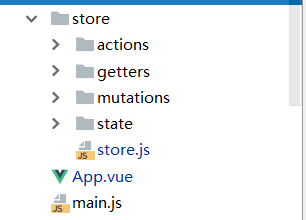将store文件夹分为四个文件夹,分别是actions,getters,mutations,state。
action:和mutatation功能是类似的,都是修改state里面的数据,区别是action用于异步修改
getter:后端传过来的数据,如果需要做一些处理就在getter里面写。
mutations:用于处理同步数据修改
state:存放后端传过来的原生数据。
父组件通过调用action对store里面数据进行了处理,他的子组件只要调用getter就可以获取到父组件处理后的数据
如下是文件结构:
这里我们演示一个小栗子:
state.js
export default{
count: 0,
firstName: 'zha',
lastName: 'lu'
}
getter.js:拼接两个字符串
// 和computer一样,都是对后台返回的数据做处理,只是这个可以应用多个页面
export default {
fullName (state) {
const name = state.firstName + state.lastName
return name
}
}
mutations.js 执行函数updateCount
// 所有数据的修改都尽量放在mutations,将mutation写成一个对象,它同步操作,不能有异步的代码在里面
export default{
// 只能有两个参数
updateCount (state, num) {
state.count = num
}
}
actions.js 每隔一段时间提交updateCount
// 和mutations差不多,区别是是action可以存放异步的代码
export default {
updateCountAsync (store, data) {
setTimeout(() => (
store.commit('updateCount', data.num)
), data.time)
}
}
store.js:上面几个都需要在这里进行注册
import Vuex from 'vuex'
import defaultState from './state/state.js'
import mutations from './mutations/mutations'
import getters from './getters/getters.js'
import actions from './actions/actions.js'
// 通过函数,返回一个store
export default () => {
return new Vuex.Store({
state: defaultState,
mutations,
getters,
actions
})
}
App.vue
<template> <div id="app"> <img src="./assets/logo.png"> <router-link to="/second">second</router-link> <router-view/> {{counter}} {{fullName}} </div> </template> <script> import { mapState, mapGetters, mapMutations, mapActions } from 'vuex' export default { name: 'App', mounted () { console.log(this.$store) // let i = 1 // actions异步处理,未使用mapActions // this.$store.dispatch('updateCountAsync', { // num: 5, // time: 2000 // }) // 使用mapActions,在调用方法的时候不用传方法名 this.updateCountAsync( { num: 5, time: 2000 }) // mutations同步处理,每隔一秒进行count+1 // setInterval(() => { // this.$store.commit('updateCount', i++) // }, 1000) }, computed: { /* count () { return this.$store.state.count },和下面的mapState功能一致 ...要使用命令 npm i babel-preset-stage-1 */ ...mapState({ // counter: 'count'和下面一样,只是这个是传对象,下面是传方法 counter: (state) => state.count }), ...mapGetters(['fullName']) // 和上面一样fullName () { // return this.$store.getters.fullName // } }, methods: { ...mapActions(['updateCountAsync']), ...mapMutations(['updateCount']) } } </script> <style> #app { font-family: 'Avenir', Helvetica, Arial, sans-serif; -webkit-font-smoothing: antialiased; -moz-osx-font-smoothing: grayscale; text-align: center; color: #2c3e50; margin-top: 60px; } </style>